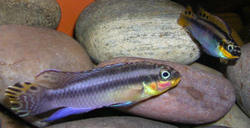Ryze_Gr
New Member
- Messages
- 16
- Location
- Patras,Greece
Hi.
I will have a pair of Pelvicachromis taeniatus ‘Moliwe’ in a few days and I would like to make a perfect aquarium for them,just as their biotope.
I know that they are being collected in west Cameroon,near Moliwe's village and I have some questions about that.What is the name of the river that they are being collected?
Is the water clean or full of tannins like Amazon?
tjudy told me some information about their biotope.If I can find more that would make my try easier and my fish happier.:biggrin:
In which other places in West Africa we can found this form and how is this biotope?
Sorry for too many questions but these fishes are adorable and I want to provide them the best conditions.
Thank you.
I will have a pair of Pelvicachromis taeniatus ‘Moliwe’ in a few days and I would like to make a perfect aquarium for them,just as their biotope.
I know that they are being collected in west Cameroon,near Moliwe's village and I have some questions about that.What is the name of the river that they are being collected?
Is the water clean or full of tannins like Amazon?
tjudy told me some information about their biotope.If I can find more that would make my try easier and my fish happier.:biggrin:
In which other places in West Africa we can found this form and how is this biotope?
Sorry for too many questions but these fishes are adorable and I want to provide them the best conditions.
Thank you.
